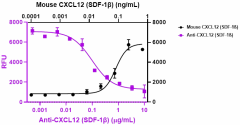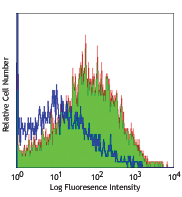- Clone
- W15149B (See other available formats)
- Regulatory Status
- RUO
- Other Names
- Bone morphogenetic protein 14 (BMP14), cartilage-derived morphogenetic protein 1 (CDMP1), BDA1C, Lipopolysaccharide Pre-B-cell growth-stimulating factor (PBSF), stromal cell derived factor 1 isoform beta precursor (SDF-1β)
- Isotype
- Rat IgG2a, κ
- Ave. Rating
- Submit a Review
- Product Citations
- publications

-

Recombinant mouse CXCL12 (SDF-1β) (Cat. No. 589806) (black circles) induces the chemotaxis of mouse Baf3-hCXCR4 transfectant chemoattractant cells. Ultra-LEAF™ purified anti-CXCL12 (SDF-1β) antibody (clone W15149B) (purple squares) neutralizes the chemotaxis of recombinant mouse CXCL12 (SDF-1β) on mouse Baf3-hCXCR4 cells in a dose-dependent manner. ND50 range: 0.05 - 0.3 µg/mL. -

Recombinant mouse CXCL12 (SDF-1α) (Cat. No. 578706) (black circles) induces the chemotaxis of mouse Baf3-hCXCR4 transfectant chemoattractant cells. Ultra-LEAF™ purified anti-CXCL12 (SDF-1β) antibody (clone W15149B) (purple squares) neutralizes the chemotaxis of recombinant mouse CXCL12 (SDF-1α) on mouse Baf3-hCXCR4 cells in a dose-dependent manner. ND50 range: 0.05 - 0.3 µg/mL. -

Recombinant human CXCL12 (SDF-1α) (Cat. No. 581206) (black circles) induces the chemotaxis of mouse Baf3-hCXCR4 transfectant chemoattractant cells. Ultra-LEAF™ purified anti-CXCL12 (SDF-1β) antibody (clone W15149B) (purple squares) neutralizes the chemotaxis of recombinant human CXCL12 (SDF-1α) on mouse Baf3-hCXCR4 cells in a dose-dependent manner. ND50 range: 0.02 - 0.12 µg/mL. -

Recombinant human CXCL12 (SDF-1β) (Black Circles, Cat. No. 587706) induces the chemotaxis of mouse Baf3-hCXCR4 transfectant chemoattractant cells. Ultra-LEAF™ purified anti-CXCL12 (SDF-1β) antibody (clone W15149B) (purple squares) neutralizes the chemotaxis of recombinant human CXCL12 (SDF-1β) on mouse Baf3-hCXCR4 cells in a dose-dependent manner. ND50 range: 0.8 - 4 µg/mL.
| Cat # | Size | Price | Save |
|---|---|---|---|
| 939903 | 100 µg | ¥44,820 | |
| 939904 | 1 mg | ¥118,690 |
Select size of product is eligible for a 40% discount! Promotion valid until December 31, 2024. Exclusions apply. To view full promotion terms and conditions or to contact your local BioLegend representative to receive a quote, visit our webpage.
CXCL12 is commonly known as SDF-1, with two variants, SDF-1α (89 amino acids) and SDF-1β (93 amino acids) derived from alternative splicing. They have identical amino acid sequences, differing only by the addition of four amino acids at the carboxy-terminus of the β form. CXCL12β is constitutively expressed by stromal cells. CXCL12α and β are ubiquitously expressed, and it has been suggested that their activity is regulated through differential proteolytic processing. Proteases present in serum process CXCL12α initially at the carboxy-terminus (through carboxypeptidase N) and subsequently at the amino-terminus (through CD26); while CXCL12β is only processed at the amino-terminus. These proteolytic processes affect the chemokine's ability to bind to heparin and cells as well as its ability to stimulate proliferation and chemotaxis. CXCL12α is inactivated by other enzymes such as metalloproteases, serine proteases, and leukocyte elastase. CXCL12/CXCR4 pair plays a key role in maintaining proliferation and survival of bone marrow stem cell subpopulations under stress conditions. Also, CXCL12 is highly expressed in bone marrow stromal stem cells and regulates growth and survival. CXCL12 promotes survival by inducing anti-apoptotic proteins, decreasing apoptotic proteins, and increasing transcription of cell survival genes. Data suggests that CXCL12β mediates cells' survival by enhancing autophagy in bone marrow mesenchymal stem cells. CXCL12 also plays important role in neurogenesis, neuroinflammation in CNS.
Product DetailsProduct Details
- Verified Reactivity
- Mouse, Human
- Antibody Type
- Monoclonal
- Host Species
- Rat
- Immunogen
- Recombinant mouse CXCL12 (SDF-1β)
- Formulation
- 0.2 µm filtered in phosphate-buffered solution, pH 7.2, containing no preservative.
- Endotoxin Level
- Less than 0.01 EU/µg of the protein (< 0.001 ng/µg of the protein) as determined by the LAL test.
- Preparation
- The Ultra-LEAF™ (Low Endotoxin, Azide-Free) antibody was purified by affinity chromatography.
- Concentration
- The antibody is bottled at the concentration indicated on the vial, typically between 2 mg/mL and 3 mg/mL. Older lots may have also been bottled at 1 mg/mL. To obtain lot-specific concentration and expiration, please enter the lot number in our Certificate of Analysis online tool.
- Storage & Handling
- The antibody solution should be stored undiluted between 2°C and 8°C. This Ultra-LEAF™ solution contains no preservative; handle under aseptic conditions.
- Application
-
Neut - Quality tested
- Recommended Usage
-
Each lot of this antibody is quality control tested by neutralization of the chemotaxis induced by recombinant mouse CXCL12 (SDF-1β) on mouse Baf3-hCXCR4 transfectant chemoattractant cells. ND50 range: 0.05 - 0.3 µg/mL. It is recommended that the reagent be titrated for optimal performance for each application.
Each lot of this antibody is quality control tested by neutralization of the chemotaxis induced by recombinant mouse CXCL12 (SDF-1α) on mouse Baf3-hCXCR4 transfectant chemoattractant cells. ND50 range: 0.05 - 0.3 µg/mL. It is recommended that the reagent be titrated for optimal performance for each application.
Each lot of this antibody is quality control tested by neutralization of the chemotaxis induced by recombinant human CXCL12 (SDF-1α) on mouse Baf3-hCXCR4 transfectant chemoattractant cells. ND50 range: 0.02 - 0.12 µg/mL. It is recommended that the reagent be titrated for optimal performance for each application.
Each lot of this antibody is quality control tested by neutralization of the chemotaxis induced by recombinant human CXCL12 (SDF-1β) on mouse Baf3-hCXCR4 transfectant chemoattractant cells. ND50 range: 0.8 - 4 µg/mL. It is recommended that the reagent be titrated for optimal performance for each application. - RRID
-
AB_2894525 (BioLegend Cat. No. 939903)
AB_2894525 (BioLegend Cat. No. 939904)
Antigen Details
- Structure
- Chemokine
- Distribution
-
Expressed by bone marrow stromal cells, pericytes, fibroblasts, endothelial cells, epithelial cells, dendritic cells, astrocytes, hematopoietic stem and progenitors, leukocytes, lymphocytes, macrophages, megakaryocytes, microglia, monocytes, neuron stem cells, neurons
- Function
- CXCL12 is a constitutive chemokine involved in lung, brain, joint, and intestine inflammation. CXCL12 is chemotactic for T, B, and cancer cells. CXCL12/CXCR4 pair plays a role in mobilization of CD34+ progenitors to peripheral blood. CXCL12 is important in morphogenesis, angiogenesis, cancer metastasis, neurogenesis and neuroinflammation.
- Interaction
- Endothelial cells, epithelial cells, T and B cells, monocytes
- Ligand/Receptor
- CXCR4
- Cell Type
- Astrocytes, Dendritic cells, Endothelial cells, Epithelial cells, Hematopoietic stem and progenitors, Leukocytes, Lymphocytes, Macrophages, Megakaryocytes, Microglia, Monocytes, Neural Stem Cells, Neurons
- Biology Area
- Angiogenesis, Apoptosis/Tumor Suppressors/Cell Death, Cancer Biomarkers, Cell Biology, Cell Death, Immuno-Oncology, Immunology, Innate Immunity, Neurodegeneration, Neuroinflammation, Neuroscience, Protein Trafficking and Clearance, Stem Cells
- Molecular Family
- Adhesion Molecules, Cytokines/Chemokines, GPCR
- Antigen References
-
1. Nagasawa T, et al. 1994. Proc Natl Acad Sci USA. 91:2305.
2. Muller A, et al. 2001. Nature. 410:50.
3. Valenzuela-Fernandez A, et al. 2002. J Biol Chem. 277:15677.
4. De La Luz Sierra M, et al. 2004. Blood. 103:2452.
5. Kortesidis A, et al. 2005. Blood. 105:3793.
6. Davis DA, et al. 2005. Blood. 105:4561.
7. Zlotnik A. 2008. J Pathol. 215:211.
8. Herberg S, et al. 2013. PLoS One. 8:e58207. - Gene ID
- 6387 View all products for this Gene ID
- UniProt
- View information about CXCL12 on UniProt.org
Related FAQs
- Do you guarantee that your antibodies are totally pathogen free?
-
BioLegend does not test for pathogens in-house aside from the GoInVivo™ product line. However, upon request, this can be tested on a custom basis with an outside, independent laboratory.
- Does BioLegend test each Ultra-LEAF™ antibody by functional assay?
-
No, BioLegend does not test Ultra-LEAF™ antibodies by functional assays unless otherwise indicated. Due to the possible complexities and variations of uses of biofunctional antibodies in different assays and because of the large product portfolio, BioLegend does not currently perform functional assays as a routine QC for the antibodies. However, we do provide references in which the antibodies were used for functional assays and we do perform QC to verify the specificity and quality of the antibody based on our strict specification criteria.
- Does BioLegend test each Ultra-LEAF™ antibody for potential pathogens?
-
No, BioLegend does not test for pathogens in-house unless otherwise indicated. However, we can recommend an outside vendor to perform this testing as needed.
- Have you tested this Ultra-LEAF™ antibody for in vivo or in vitro applications?
-
We don't test our antibodies for in vivo or in vitro applications unless otherwise indicated. Depending on the product, the TDS may describe literature supporting usage of a particular product for bioassay. It may be best to further consult the literature to find clone specific information.
Other Formats
View All CXCL12 Reagents Request Custom Conjugation| Description | Clone | Applications |
|---|---|---|
| Ultra-LEAF™ Purified anti-CXCL12 (SDF-1β) | W15149B | Neut |
Customers Also Purchased
Compare Data Across All Formats
This data display is provided for general comparisons between formats.
Your actual data may vary due to variations in samples, target cells, instruments and their settings, staining conditions, and other factors.
If you need assistance with selecting the best format contact our expert technical support team.
















Follow Us